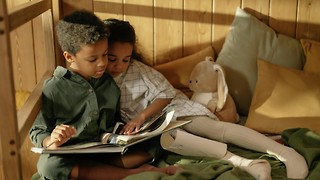Calling all Ghostbusters
Most of us envision ghosts as semi-transparent figures in white sheets – commonplace in escapist fiction, but absent from real life. Zoe Large finds them far less otherworldly

Right, I’ll put this straight out there: I’m about to argue that ghosts are real.
...Are those alarm bells I hear, or the tubular bells of The Exorcist soundtrack?
To set your mind at ease, no, I’m not a veiled witch-type conjuring ‘ghostly’ voices from my crystal ball. Nor am I particularly interested in the ‘paranormal’ figures which, thanks to the likes of Harry Potter and The Ghost Whisperer, are now rivalling reality-TV celebs as the most irritatingly ubiquitous features of popular culture. On second thought, perhaps that’s a false distinction to make – to the nation’s amusement, psychic cable channels and Most Haunted have taken ghosts out straight of the fantasy realm, aiming to turn them into ‘reality’ stars in their own right.
Let’s be honest: the most haunting feature of those programmes has got to be Derek Acorah himself. Richard Dawkins is probably quite right to detect ‘cynical contempt for the viewers’ IQ’ in this ‘epidemic of paranormal propaganda’. As the argument of Unweaving the Rainbow continues, however, Dawkins’s claims become far more contentious. In his opinion, belief in such obvious quackery is equivalent to all unempirical faith. Inklings of the supernatural, he would have us believe, are the sole preserve of the infantile or superstitious, equivalent to faith in the Tooth Fairy, Santa Claus or – most controversially – God. It’s all very well for children and the intellectually-challenged to occupy themselves with such wacky beliefs, we infer, but ‘serious’ people must go on thinking scientifically.

Offensive though it may be, there is some significance in Dawkins’s comparison between religious belief and popular interest in these dubious on-screen ‘spirits’. Ask your friend to describe a ghost, and they’ll probably recall either Casper or a wan, ruff-wearing Tudor lady. Yet such secularity would have been unthinkable five hundred years ago – for Catholics of the sixteenth century, ghosts were spirits risen from Purgatory. Go right back to the myths and legends of ancient folklore, and you’ll find spirits dressed in ever-more unfamiliar, yet still religious forms. Clearly, these creatures of the paranormal are constantly evolving in the eye of popular imagination.
Evolving, perhaps, but never disappearing from its gaze. Dawkins’s ‘epidemic of paranormal propaganda’ is not such a modern phenomenon after all – in fact, anthropologists have yet to discover any bygone culture which lacks some version of these beliefs. Like angels, gods and goddesses, ghosts can thus be understood as time-honoured mechanisms for projecting universal elements in human consciousness. In Jung’s terms, they are ‘archetypal’ symbols: primordial forms of expression which reoccur everywhere and always, and order the general experience of mankind. As such, they are also the forms in which art meets religion.

Take the story now known as The Book of Tobit, for instance, as told in the Apocrypha of the Protestant Bible. First written down in 150BC by the Jewish Diaspora (but told orally many centuries before that), the story tells how the Archangel Raphael helps a sick man to recover his family debt, and to wed a young woman who had once been possessed by an evil spirit. Since its creation almost 3000 years ago this tale of supernatural intervention has fascinated many artists – most notably Guardi, who famously retells the story in his own series of paintings. Centuries of art and religion testify to its timeless fascination - each generation has interpreted it in a new way, adding new light and new lustre to its content, yet the core sentiment has survived.
In this way, angels, ghosts, gods and goddesses possess their own kind of ‘reality’: quite different from the testability demanded by Dawkins, perhaps, yet no less important. They provide ways of manifesting elements of the psyche which would otherwise remain invisible; those mysterious moments in human life which feel deeply imbued with meaning, yet escape full comprehension. This is surely why they have fascinated artists for thousands of years - Shakespeare might not have believed in ghosts as they appear in his plays, but he certainly believed, as most of us do, that the living can be powerfully affected by the deceased. Angels exist in the same way – not as winged beings in ethereal nightgowns, but dramatisations of real, yet formless elements of physics, and as powerful symbols for the creative imagination.

If these images are now ridiculed as whimsical products of escapist fantasy, it is because – like most things embraced by popular culture - they have become increasingly secularised and perverted. In their bastardized form they offer an easy target for Dawkins’s reductionist materialism, (... it’s hard to take anything seriously when it’s associated with Derek Acorah), though their transformation comes dangerously close to embodying his very own values. Like the particularities favoured in previous centuries, our own versions of these symbols offer a penetrating, if worrying insight into the culture which has produced them.
We would do well, however, to try and re-acknowledge their real significance. Mythical archetypes might decay, but they can never disappear, even in the most positivist of cultures. Unlike a certain bouffant-haired, Northern ‘psychic’, these symbols provide a real point of dialogue with our past. As part and parcel of the human being, they will also carry us into the future.
 News / Uni offers students £55k in payouts31 October 2025
News / Uni offers students £55k in payouts31 October 2025 News / Uni error forces deeper spending cuts31 October 2025
News / Uni error forces deeper spending cuts31 October 2025 News / College rowing captains narrowly vote to exclude trans women31 October 2025
News / College rowing captains narrowly vote to exclude trans women31 October 2025 News / Students launch women’s society excluding trans women31 October 2025
News / Students launch women’s society excluding trans women31 October 2025 News / Cambridge launches plan to bridge ‘town and gown’ divide27 October 2025
News / Cambridge launches plan to bridge ‘town and gown’ divide27 October 2025









